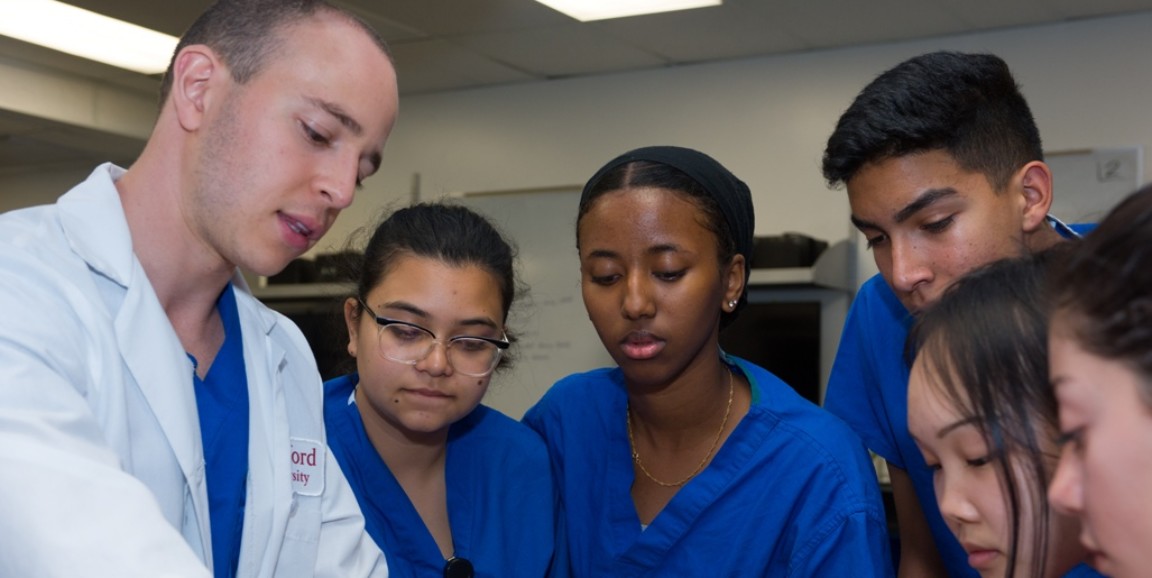Each summer, 24 low-income high school students travel from counties across Northern California and move onto the Stanford campus. For five weeks, and at no cost, they live together, bond with their classmates and Stanford undergraduate counselors, and dive into a whirlwind curriculum packed with medical lectures, labs, hospital internships and workshops on college admissions.
The Stanford Medical Youth Science Program has been making this experience possible for 30 years. This summer, the program will pass 700 alumni — just one measure of the huge impact it has had on students and communities that might otherwise face insurmountable barriers to education and careers in medical and health science.
For my recent story about the program, I joined the students and counselors for several activities during their second week: a Jeopardy-style curriculum-quiz game, a hands-on human anatomy lab, workshops on health disparities and race and ethnicity, and a group activity at the residence where students could share their thoughts and feelings on a topic and begin to trust and connect with each other. It was easy to see why so many Stanford undergraduates, medical students, faculty mentors, physician-scientist lecturers, and hospital staff are drawn to participate in and support the program.
Almost everyone I spoke to mentioned how important the feeling of bonding was for students and counselors alike. "This is a program for students who are low-income, who often experience high levels of adversity," said Alivia Shorter, executive director of the program. "And for counselors, it’s not just a summer job. It’s a transformative experience for counselors, too, many of whom come from a similar background and see that a mentor really changed their lives, and they want to now do that for someone else."
Shorter understands, because she, too, came to Stanford from a low-income childhood in the Salinas Valley area. Before coming to Stanford, she said, she had never met a single person who had gone to college. In 2008, after her sophomore year at Stanford, she served as a counselor in the program.
The founder of the program, Marilyn Winkleby, MPH, PhD, now a professor emerita of medicine at the Stanford Prevention Research Center, has mentored many alumni for years after they finish the program, supporting them as they navigate the academic and professional worlds. "When I came to Stanford, given my background, I had to learn to walk in the world of Stanford. And that was challenging," Winkleby, who grew up on a two-acre farm in Vista, California, told me. "We’re empowering these students to know that you can walk in both worlds. We’re empowering them to know that they’re smart, they belong in college and we need them in health careers."
Homar Murillo, 17, a rising senior from Leadership Public High School in Hayward, meanwhile, had this to say: "I expected study, study, study, study, and no one talking to each other. But you walk into these doors and it’s like you have a whole new family. I’ve never gotten so close to people as I have in this program. I haven’t had so much academic support with people I barely know."
The intersection of academic rigor and personal support reinforces the students’ chances of success. And the results are undeniable: In California, where 80 percent of students who fail to complete high school are low-income, the Stanford Medical Youth Science program helps shift the statistics: Close to 100 percent of participants in the program graduate from high school, and just over 80 percent graduate from a four-year college. More than 50 percent of students in the program either enter the health professions or pursue advanced graduate degrees and later enter careers as clinicians or in other areas of health.
While the program benefits the students personally, it also has the potential to influence the many classmates and family members who’ve been cheering them on from home. "We can only touch 24 lives each summer. But the students take home so much," Shorter pointed out. "They’re changing their communities the day they go home. It doesn’t just happen years from now when they become doctors. We don’t have to wait for them to be leaders. They are leaders right this very second."
Photo by Steve Fisch




